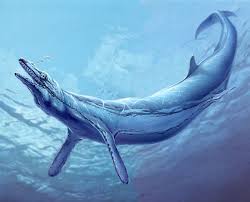|
|
Post by dinosauria101 on Aug 16, 2019 20:04:44 GMT 5
Basilosaurus cetoides Basilosaurus meaning "king lizard", is a genus of large, predatory, prehistoric cetaceans that is known from well preserved fossils found in Lutetian, Bartonian and Priabonian stage deposits during the late Eocene approximately 41.3 to 33.9 million years ago. Measuring 15–20 m, Basilosaurus is one of the largest-known animals to exist from K–Pg extinction event 66 million years ago (mya) to around 15 million years ago when modern cetaceans began to reach enormous sizes. Basilosaurus lived in the tropical Tethys Sea.  Pliosaurus macromerus Pliosaurus (meaning 'more lizard') is an extinct genus of thalassophonean pliosaurid known from the Kimmeridgian and Tithonian stages (Late Jurassic) of Europe and South America. Their diet would have included fish, cephalopods, and marine reptiles. This genus has contained many species in the past but recent reviews found only six to be valid, while the validity of two additional species awaits a petition to the ICZN. Most species of Pliosaurus are notable for their large body size, while the others, P. brachydeirus, P. brachyspondylus and P. portentificus, are known exclusively from immature individuals. Pliosaurus macromerus would have been one of the largest, at up to 20 tons.  Credit to Wikipedia |
|
|
|
Post by poseidon on Jul 24, 2021 20:49:01 GMT 5
I'd favor pliosaurus, he is a lot more robust than the slender basilo and could just use his powerful jaws to rip basilo to shreds
|
|
|
|
Post by jhg on Oct 18, 2024 19:43:16 GMT 5
Really? These two are of comparable size assuming P. macromerus is even valid.
|
|